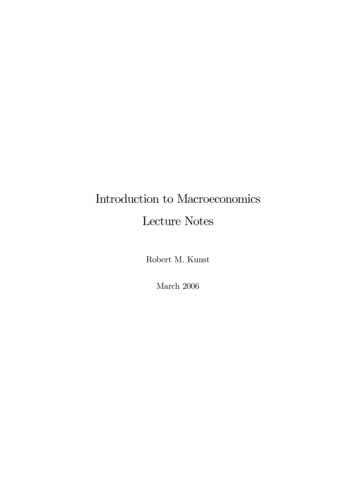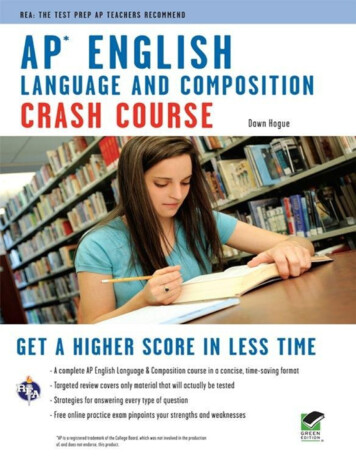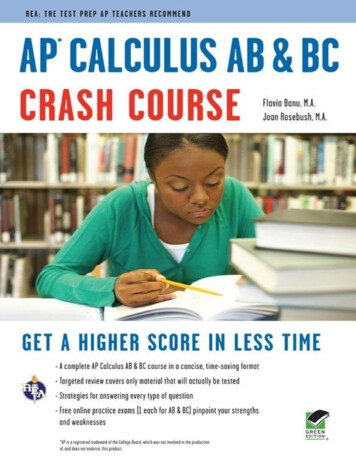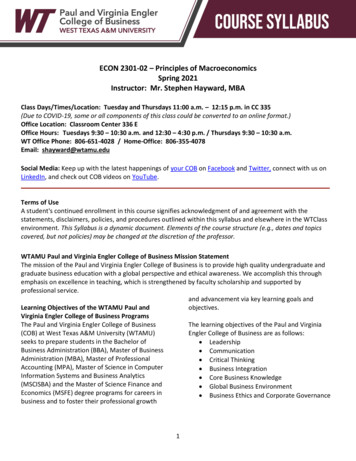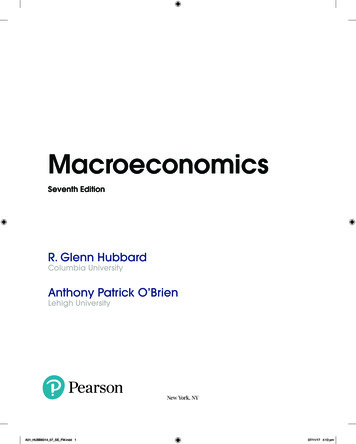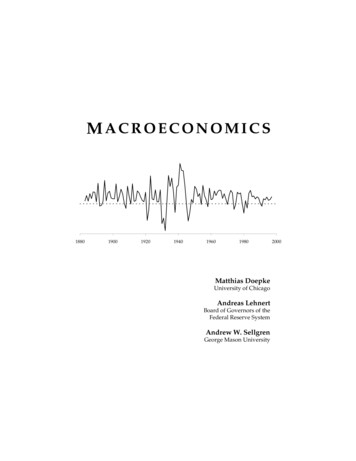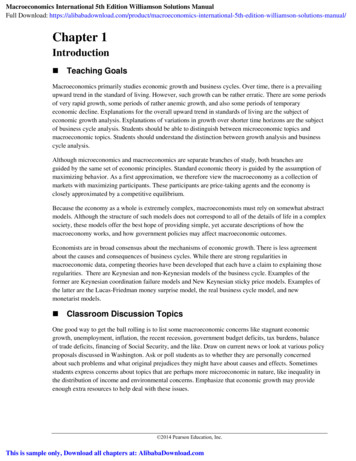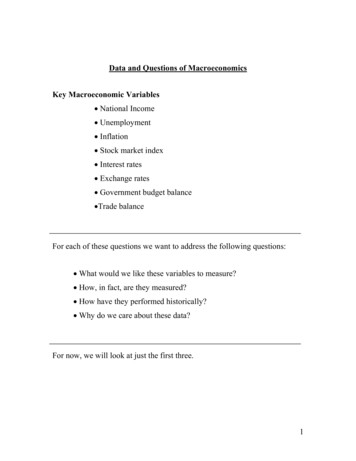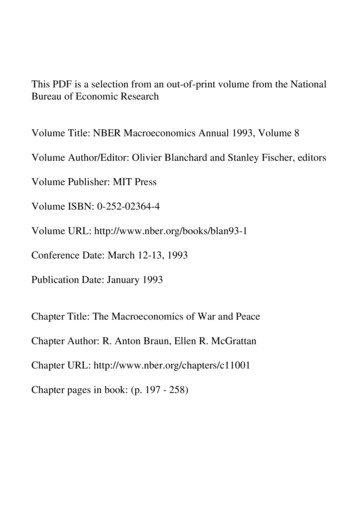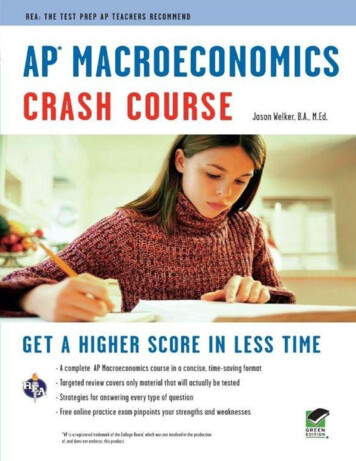
Transcription
Planet Friendly Publishing Made in the United States Printed on Recycled Paper Text: 10% Cover: 10%Learn more: www.greenedition.orgAt REA we’re committed to producing books in an earth-friendly manner and to helping our customersmake greener choices.Manufacturing books in the United States ensures compliance with strict environmental laws andeliminates the need for international freight shipping, a major contributor to global air pollution.And printing on recycled paper helps minimize our consumption of trees, water and fossil fuels. Thisbook was printed on paper made with 10% post-consumer waste. According to EnvironmentalDefense’s Paper Calculator, by using this innovative paper instead of conventional papers, we achievedthe following environmental benefits:Courier Corporation, the manufacturer of this book, owns the Green Edition Trademark.Trees Saved: 4 Air Emissions Eliminated: 697 poundsWater Saved: 673 gallons Solid Waste Eliminated: 205 poundsFor more information on our environmental practices, please visit us online at www.rea.com/green
Research & Education Association61 Ethel Road WestPiscataway, New Jersey 08854E-mail: info@rea.comAP MACROECONOMICS CRASH COURSECopyright 2012 by Research & Education Association, Inc. All rights reserved. No part of this bookmay be reproduced in any form without permission of the publisher.Printed in the United States of AmericaLibrary of Congress Control Number 20119319509780738669656LIMIT OF LIABILITY/DISCLAIMER OF WARRANTY: Publication of this work is for the purpose oftest preparation and related use and subjects as set forth herein. While every effort has been made toachieve a work of high quality, neither Research & Education Association, Inc., nor the authors and othercontributors of this work guarantee the accuracy or completeness of or assume any liability in connectionwith the information and opinions contained herein and in REA’s companion online materials. REA andthe authors and other contributors shall in no event be liable for any personal injury, property or otherdamages of any nature whatsoever, whether special, indirect, consequential or compensatory, directly orindirectly resulting from the publication, use or reliance upon this work.All trademarks cited in this publication are the property of their respective owners.REA is a registered trademark of Research & Education Association, Inc.
AP MACROECONOMICS CRASH COURSEAccess Your Exam
Table of ContentsTitle PageCopyright PageAP MACROECONOMICS CRASH COURSEABOUT THIS BOOKABOUT OUR AUTHORACKNOWLEDGMENTSPART I - INTRODUCTIONChapter 1 - Keys for Success on the AP Macroeconomics ExamChapter 2 - Key Formulas and Definitions for AP MacroeconomicsPART II - BASIC ECONOMIC CONCEPTSChapter 3 - Basic Economic ConceptsChapter 4 - Supply, Demand, and Equilibrium in Product MarketsPART III - MEASUREMENT OF ECONOMIC PERFORMANCEChapter 5 - National Income AccountsChapter 6 - Inflation Measurement and AdjustmentChapter 7 - UnemploymentPART IV - NATIONAL INCOME AND PRICE DETERMINATIONChapter 8 - Aggregate DemandChapter 9 - Aggregate SupplyChapter 10 - Macroeconomic Equilibrium in the AD/AS ModelPART V - FINANCIAL SECTORChapter 11 - Money, Banking, and Financial MarketsChapter 12 - Central Bank and Control of the Money SupplyPART VI - MACROECONOMIC POLICIES, INFLATION, AND UNEMPLOYMENTChapter 13 - Fiscal and Monetary PoliciesChapter 14 - Inflation and UnemploymentPART VII - ECONOMIC GROWTH AND PRODUCTIVITYChapter 15 - Sources of Economic Growth and ProductivityPART VIII - OPEN ECONOMY: INTERNATIONAL TRADE AND FINANCEChapter 16 - Balance of Payments AccountsChapter 17 - Foreign Exchange MarketPART IX - TEST-TAKING STRATEGIESChapter 18 - Strategies for the Multiple-Choice Questions
Chapter 19 - Strategies for the Free-Response QuestionsEconomics GlossaryWelcome to REA’s Crash Course for AP Macroeconomics
ABOUT THIS BOOKREA’s AP Macroeconomics Crash Course is the first book of its kind for the last-minute studier or anyAP student who wants a quick refresher on the course. The Crash Course is based on a careful analysisof the AP Macroeconomics Course Description outline and actual AP test questions released by theCollege Board.Written by an AP teacher, our easy-to-read format gives students a crash course in Macroeconomics. Thisreview will prepare you for test day by focusing on important topics frequently seen on the APMacroeconomics exam.Unlike other test preps, REA’s AP Macroeconomics Crash Course gives you a review specificallyfocused on what you really need to study in order to ace the exam. The introduction discusses the keys forsuccess and includes a list of terms all AP Macroeconomics students must know.The targeted review chapters are grouped by topics, offering you a concise way to learn all the importantideas, facts, and terms before exam day. The author gives you expert test-taking strategies to conquer themultiple-choice and free-response questions on the exam.No matter how or when you prepare for the AP exam, REA’s AP Macroeconomics Crash Course willshow you how to study efficiently and strategically, so you can boost your score!To check your test readiness for the AP Macroeconomics exam, either before or after studying this CrashCourse, take our online practice exam. To access your free practice exam, visitwww.rea.com/studycenter and follow the on-screen instructions. This true-to-format test featuresautomatic scoring of the multiple-choice questions and detailed explanations of all answers. Ourdiagnostic analysis will help you identify your strengths and weaknesses, so you’ll be ready on exam day!Good luck on your AP Macroeconomics exam!
ABOUT OUR AUTHORJason Welker’s interest in economics began in the late 1990s, when, as a high school student studyingeconomics at an international school in Malaysia, he experienced firsthand the effects of the Asianfinancial crisis that saw the economies of Southeast Asia plunge into recession and trigger widespreadpolitical unrest. At university in Seattle, Jason once again witnessed the power that economics holds oversociety when the World Trade Organization’s Seattle summit attracted tens of thousands of protesters,whose anger over globalization escalated into riots. From these experiences, and with the inspirationprovided by his Intro to Economics professors, Jason decided he wanted to dedicate his studies tounderstanding the role economics plays in shaping human societies. His personal economics educationhas continued ever since.Jason’s international teaching career has taken him to schools in Thailand, China, and most recently toSwitzerland, where he is currently teaching Advanced Placement and International BaccalaureateEconomics at an international school in Zurich, the financial capital of Europe.In addition to teaching economics to nearly 100 students from 40 countries each year, Jason writes a blogfor Economics students around the world which can be read athttp://www.welkerswikinomics.com/home.html. He has also led workshops on technology in theEconomics classroom at AP Summer Institutes and at the National Center for Economics Educationconference in Washington, D.C. He has recently completed a textbook for the IB Economics curriculum,and is constantly developing and making available many other resources for Econ students through hiswebsite. His latest venture, AP Macroeconomics Crash Course, provides students with a powerfulresource for use in preparation for their AP exams.
ACKNOWLEDGMENTSIn addition to our author, we would like to thank Larry B. Kling, Vice President, Editorial, for his overallguidance, which brought this publication to completion; Pam Weston, Publisher, for setting the qualitystandards for production and managing the publication to completion; Diane Goldschmidt, Senior Editor,for editorial project management; Alice Leonard and Kathleen Casey, Senior Editors, for preflighteditorial review; and Weymouth Design, for designing our cover.We would also like to extend special thanks to Tyson Smith of Iowa City West High School fortechnically reviewing the manuscript, Elizabeth Catafalmo for copyediting, Caroline Duffy forproofreading, and Kathy Caratozzolo of Caragraphics for typesetting this edition.
PART IINTRODUCTION
Chapter 1Keys for Success on the AP Macroeconom ics ExamThe subject of macroeconomics is vast in content and at the university level it may be taught over the spanof several years of courses. In fact, one could even major in a macroeconomic topic and pursue advanceddegrees within the field. You, on the other hand, are probably taking AP Macroeconomics as a one- orpossibly two-semester high school course in the 11th or 12th grade.So how can a high school student be expected to learn all the content that may be consideredmacroeconomics and be prepared enough to score a respectable mark on the Advanced Placement exam?Rest assured, with a few crucial pieces of information and some important hints and tips, you can focusyour studies in and out of the classroom toward the most important concepts that are most likely to beaddressed on the AP Macro exam.This Crash Course, along with your course textbook, your teacher, your classmates and countless onlineresources, is your single greatest key to success on the AP Macro exam. There is no shortage of resourcesin print and online for the high school economics student today. But with all the information out there, anda syllabus that spans seven units of macroeconomic study, how do you know what is the most importantmaterial to study for the AP Macro exam?
RELATIVE IMP ORTANCE OF THE AP MACRO UNITSON THE EXAMWith all the information out there, how do you know in what areas to focus? One thing all AP Macrostudents should know as they progress through the course and prepare for the exam is the relativeimportance of each of the units in the course.The AP Macro exam is a two-part examination. The first part is a 60-question multiple-choice (MC) test.The 60 questions come from the seven units of the AP Macro course. Thankfully, the AP makes public theapproximate percentage of the 60 multiple-choice questions that will come from each of the sevensections of the course. The breakdown is as follows: Unit 1: Basic Economic Concepts, Supply, Demand, and Equilibrium (8–12 percent) Unit 2: Measurement of Economic Performance (12–16 percent) Unit 3: National Income and Price Determination (10–15 percent) Unit 4: The Financial Sector (15–20 percent) Unit 5: Macroeconomic Policies, Inflation, and Unemployment (20–30 percent) Unit 6: Economic Growth and Productivity (5–10 percent) Unit 7: Open Economy: International Trade and Finance (10–15 percent)With the approximate percentages of each unit’s representation on the multiple-choice section of theexam, you can focus your exam studies appropriately. For example, you can see above that the mostcommonly tested units are Unit 4—The Financial Sector, and Unit 5—Macroeconomic Policies. Thesetwo units together could make up as much as 50 percent of the 60 questions on the multiple-choice sectionof the exam.As you use this Crash Course to study, you will notice that the most heavily assessed units are given themost attention in this book. Units 4 and 5, for example, account for more than 60 pages. In this way, thenumber of pages dedicated to each unit in the Crash Course is roughly representative of the weight thatunit is given on the AP exam.The free-response question (FRQ) section of the exam includes three questions. The first question isalways a long FRQ, on which you are expected to spend approximately 30 minutes planning andanswering. The second and third questions are short FRQs, on which you are expected to spendapproximately 15 minutes planning and answering. The topics the FRQs cover could come from anysection of the syllabus, although there are certain topics that are more commonly tested than others, givingthe FRQ section some degree of predictability. The last two chapters of this Crash Course provide moreinformation about how to best prepare for these two sections of the AP exam.
GRADE SCALE F OR THE AP MACRO EXAMYou may think with all the units in this course and only one or two semesters to learn them all, you’llnever be able to get a 5 on the AP Macroeconomics exam. However, getting a 4 or 5 on the AP Macroexam may not be as difficult as you might think. The table below shows the approximate range of scoresneeded to earn each of the possible AP scores, from the top mark of 5 to the lowest score of 1.Keep in mind that the exam includes a 60-question multiple-choice section and a 3-question free-responsesection. The free-response questions will always be weighted so that the long question is worth half thefree-response points and the short questions will each be worth a quarter of the free-response points. Themultiple-choice section is worth twice as much as the free-response portion. In addition, the exact rangeof each of the five possible grades will vary depending upon how students who took the exam perform.But usually, the range of scores is as follows:APG ra deMinimum Pe rc e nt a g e Co rre c t o n MC a nd FRQ Se c t io nsCo mbine d581%462%348%233%10%The score ranges indicated above are only an approximation. In 2011, the AP stopped subtracting aquarter of a point for each wrong multiple-choice answer, which it had done in the past. Therefore, theabove scale is only an approximation based on past years, in which the AP did subtract quarter points forwrong answers. As mentioned above, the precise score range is adjusted every year based on theperformance of students worldwide on that year’s exam.
WHEN TO GUESS IN THE MULTIP LE-CHOICE SECTIONStudents often wonder, “If I have no idea which of the five options is correct, should I guess?” In pastyears, the answer would have been, not necessarily, since a wrong guess could result in a 0.25-pointpenalty against your final score. But since May 2011, there is no longer a penalty for wrong answers.Therefore, guessing is always advised if, of course, you have no idea of the correct answer. Beforeresorting to a blind guess, you should use all your knowledge and understanding of economics to eliminatethe possible incorrect answers, so that any guess you are forced to make is an educated guess.
USING RELEASED EXAMS TO P REPAREThe College Board is very protective of its past multiple-choice examinations, and in fact only releasesan exam to the public once every five years. (The next to be released is the 2010 exam, which willbecome available in late 2011.) These multiple-choice exams are not given to the public. Instead schoolsmust purchase them from the College Board, and these schools are then asked to protect the examscarefully. Chances are, your AP Macro teacher has access to some of these past exams and uses them tohelp write the tests you take every few weeks in the class.So what is a student to do when it comes to practicing real AP questions? The good news is, the AP doesmake many resources available to students that you will find useful in your preparation. The entire 1995multiple-choice section is available for download online, for example, as are more than 10 years of pastfree-response questions.The website you should bookmark and use frequently throughout the AP Macro course, especially whenpreparing for the exam, is the College Board’s site for AP Macroeconomics ng/ap/economics macro/samp.html?macro).This site includes the following: Sample free-response questions and scoring guidelines; Official topic outline; Exam information; A link to the course description, which includes sample multiple-choice questions.
THE IMP ORTANCE OF DIAGRAMS IN THE AP MACROCOURSETo earn a 4 or 5 on the AP Macro exam, you must possess more than just a solid understanding of thecourse material. You also must be skilled at illustrating the concepts from the course in detailed, correctlydrawn economics diagrams.The good news is, all the graphs you need to know are drawn exactly as they should be drawn in the examright here in this Crash Course. Study these diagrams closely as you progress through this book. Examinethe labels, the shapes of the lines, the way arrows are used to indicate directions of shifts, and the waydotted lines are used to identify equilibrium points on the axes. Seek to understand the meaning of thevarious macroeconomic models in this book, and don’t just memorize them.Drawing graphs well (and being able to interpret their meaning in the MC section) is a crucial skill thatwill ensure you impress the examiners who read your free-response answers. Each line on a graph shouldbe seen as telling a story—a relationship between the variables on the axes of that particular graph. If youstrive for understanding why each line is shaped as it is, of what it is composed, and which factors canshift it, you will perform well on graph-based questions whether you encounter them in the MC or freeresponse section of the test.
USING THE AP MACROECONOMICS CRASH COURSETO P REPARE F OR SUCCESSThis Crash Course has been written based on careful analysis of the AP Macroeconomics CourseDescription and on past multiple-choice and free-response questions. Chapter 2 contains key formulasand definitions that you absolutely need to know. Chapters 3–17 provide you with a detailed examinationof each of the topics from the AP Macro syllabus, in the same order as the syllabus itself. Along withwritten explanations, these chapters include precisely drawn diagrams. Study these diagrams closely, andas you prepare for the exam, practice drawing all the graphs you see in this book on your own.This book contains all the information you need to know to earn a score of 4 or 5, but the book alonecannot get you that high score. The best AP Macro students will use this book as just one of the manyresources available, the most valuable of which is your own notes taken in class and at home. You shouldalso have a textbook, and maybe even an exam prep book that includes practice AP-STYLE questions, tohelp you prepare.The Crash Course is a detailed outline of the course, but does not go into great depth or provide manyexamples of the theories and concepts covered. You should depend on your teacher, your classmates,textbooks, and online resources for that information. Use this book to supplement the learning you doelsewhere and in the last few weeks before the big exam.
Chapter 2Key Form ulas and Definitions for APMacroeconom ics
I. K ey F ormulas1. GDP C I G Xn: The expenditure approach to measuring GDP correlates well with aggregatedemand (AD).2. GDP W I R P: The income approach to measuring GDP correlates well with aggregatesupply (AS).3. Calculating Nominal GDP: The quantity of various goods produced in a nation times their currentprices, added together.4. GDP Deflator: A price index used to adjust nominal GDP to arrive at real GDP. Called the“deflator” because nominal GDP will usually overstate the value of a nation’s output if there hasbeen inflation. The Consumer Price Index (CPI) is another commonly used price index.5. Real GDP:6. GDP Growth Rate:growth rate is a percentage change in a nation’s real output between one year and the next.7. The Inflation Rate via the CPI:is the percentage change in the CPI from one period to the next.8. Real Interest Rate nominal interest rate–inflation rate.9. The labor force includes all noninstitutionalized people of working age who are employed or seeking employment.10.where RRR equals the required reserve ratio. Application: An initialinjection of 1,000 of new money into a banking system with a reserve ratio of 0.1 will generate upto 1,000 (10) 10,000 in total money.11. Quantity Theory of Money: MV PQ Y. A monetarist’s view that explains how changes in themoney supply (M) will affect the price level (P) and/or real output assuming the velocity of money(V) is fixed in the short run.12. MPC MPS 1. The fraction of an increase in disposable income that is spent (MPC) plus thefraction that is saved (MPS) must equal 1.13. This tells you how much total spending an initial injection
of spending in the economy will generate. For example, if the MPC .8 and the government spends 100 million, then the total increase in spending in the economy 100 5 500 million.14. This tells you how much total spending will result from an initial changein the level of taxation. It is negative because when taxes decrease, spending increases, and viceversa. The tax multiplier will always be smaller than the spending multiplier.
II. K ey Definitions1. Absolute Advantage: A country or individual has an absolute advantage in the production of a goodwhen the country can produce the good using fewer resources than another country or individual.2. Aggregate Demand (AD): A schedule or curve that shows the total quantity demand for all goods andservices of a nation at various price levels at a given period of time.3. Aggregate Supply (AS): The total amount of goods and services that all the firms in all the industriesin a country will produce at various price levels in a given period of time.4. Appreciation: An increase in the value of one currency relative to another, resulting from an increasein demand for or a decrease in supply of the currency on the foreign exchange market.5. Balance of Payments: Measures all the monetary exchanges between one nation and all other nations.Includes the current account and the capital account.6. Bonds: A certificate of debt issued by a company or a government to an investor.7. Budget Deficit: When a government spends more than it collects in tax revenues in a given year.8. Business Cycle: A model showing the short-run periods of contraction and expansion in outputexperienced by an economy over a period of time.9. Capital: Human-made resources (machinery and equipment) used to produce goods and services;goods that do not directly satisfy human wants. Sometimes separated into human capital (education,know-how) and physical capital (tools you can touch and operate).10. Capital Account (also called the Financial Account): Measures the flow of funds for investment inreal assets (such as factories or office buildings) or financial assets (such as stocks and bonds)between a nation and the rest of the world.11. Ceteris Paribus: “Other things being equal;” used as a reminder that all variables other than the onesbeing studied are assumed to be constant.12. Circular Flow Diagram: A model of the macroeconomy that shows the interconnectedness ofbusinesses, households, government, banks, and the foreign sectors. Money flows in a circulardirection, and goods, services, and resources flow in the opposite direction.13. Classical Economic Theory: The view that an economy will self-correct from periods of economicshock if left alone. Also known as “laissez-faire.”14. Comparative Advantage: When an individual, a firm or a nation is able to produce a particularproduct at a lower-opportunity cost than another individual, firm, or nation. Comparative advantageis the basis on which nations trade with one another.15. Consumer Price Index (CPI): An index that measures the price of a fixed market basket of consumergoods bought by a typical consumer. The CPI is used to calculate the inflation rate in a nation.16. Consumption: A component of a nation’s aggregate demand; measures the total spending by domestichouseholds on goods and services.17. Contractionary Fiscal Policy: A demand-side policy whereby government increases taxes ordecreases its expenditures in order to reduce aggregate demand. Could be used in a period of highinflation to bring down the inflation rate.18. Contractionary Monetary Policy: A demand-side policy whereby the central bank reduces the supplyof money, increasing interest rates and reducing aggregate demand. Could be used to bring downhigh inflation rates.19. Cost-Push Inflation: Inflation resulting from a decrease in AS (from higher wage rates and rawmaterial prices, such as the price of oil) and accompanied by a decrease in real output andemployment. Also referred to as “stagflation” or “adverse aggregate supply shock.”20. Crowding-Out Effect: The rise in interest rates and the resulting decrease in investment spending in
.38.39.the economy caused by increased government borrowing in the loanable funds market. Seen as adisadvantageous side effect of expansionary fiscal policy.Current Account: Measures the balance of trade in goods and services and the flow of incomebetween one nation and all other nations. It also records monetary gifts or grants that flow into or outof a country. Equal to a country’s net exports, or its exports minus its imports.Cyclical Unemployment: Unemployment caused by a fall in aggregate demand in a nation. Notincluded in the natural rate of unemployment. When a nation is in a recession, there will be cyclicalunemployment.Deflation: A decrease in the average price level of a nation’s output over time.Demand Deposit: A deposit in a commercial bank against which checks may be written. Also knownas a “checkable deposit.”Demand-Pull Inflation: Inflation resulting from an increase in AD without a corresponding increasein AS.Depreciation: A decrease in the value of one currency relative to another, resulting from a decreasein demand for or an increase in the supply of the currency on the foreign exchange market.Devaluation: When a government intervenes in the market for its own currency to weaken it relativeto another currency. Usually achieved through direct intervention in the foreign exchange (forex)market or through the use of monetary policy that affects interest rates, and thereby affectsinternational demand for the currency.Discount Rate: One of the three tools of monetary policy, it is the interest rate that the federalgovernment charges on the loans it makes to commercial banks.Economic Growth: An increase in the potential output of goods and services in a nation over time.Economic Resources: Land, labor, capital, and entrepreneurial ability that are used in the productionof goods and services. They are “economic” resources because they are scarce (limited in supplyand desired). Also known as “factors of production.”Excess Reserves: The amount by which a bank’s actual reserves exceed its required reserves. Bankscan lend excess reserves; when they do, they expand the money supply. The amount of excessreserves in the banking system determines equilibrium interest rate.Exchange Rate: The price of one currency in terms of another currency, determined in the forexmarket.Exports: The spending by foreigners on domestically produced goods and services. Counts as aninjection into a nation’s circular flow of income.Federal Funds Rate (FFR): The interest rate banks charge one another on overnight loans made outof their excess reserves. The FFR is the interest rate targeted by the Fed through its open-marketoperations.Fiscal Policy: Changes in government spending and tax collections implemented by government withthe aim of either increasing or decreasing aggregate demand to achieve the macroeconomicobjectives of full employment and price-level stability.Floating Exchange Rate System: When a currency’s exchange rate is determined by the freeinteraction of supply and demand in international forex markets.Forex Market (Foreign Exchange Market): The market in which international buyers and sellersexchange foreign currencies for one another to buy and sell goods, services, and assets from variouscountries. It is where a currency’s exchange rate relative to other currencies is determined.Fractional Reserve Banking: A banking system in which banks hold only a fraction of deposits asrequired reserves and can lend some of the money deposited by their customers to other borrowers.Frictional Unemployment: Unemployment of workers who have employable skills, such as thosewho are voluntarily moving between jobs or recent graduates who are looking for their first job.
40. Full Employment: When an economy is producing at a level of output at which almost all the nation’sresources are employed. The unemployment rate when an economy is at full employment equals thenatural rate, and includes only frictional and structural unemployment. Full-employment output isalso referred to as “potential output.”41. GDP (Gross Domestic Product): The total market value of all final goods and services producedduring a given time period within a country’s borders. Equal to the total income of the nation’shouseholds or the total expenditures on the nation’s output.42. GDP Deflator: The price index for all final goods and services used to adjust the nominal GDP intoreal GDP.43. Human Capital: The value skills integrated into labor through education, training, knowledge, andhealth. An important determinant of aggregate supply and the level of economic growth in a nation.44. Imports: Spending on goods and services produced in foreign nations. Counts as a leakage from anation’s circular flow of income.45. Inflation: A rise in the average level of prices in the economy over time (percentage change in theCPI).46. Inflationary Gap: The difference between a nation’s equilibrium level of output and its fullemployment level of output when the nation is overheating (producing beyond its full employmentlevel).47. Inflationary Spiral: The rapid increase in average price level resulting from demand-pull inflationleading to higher wages, causing cost push inflation.48. Interest Rate: The opportunity cost of money. Either the cost of borrowing money or the cost ofspending money (e.g., the interest rate is what would be given up by not saving money). Conversely,this is the price a lender is paid for allowing someone else to use money for a time.49. Investment: A component of aggregate deman
This Crash Course, along with your course textbook, your teacher, your classmates and countless online resources, is your single greatest key to success on the AP Macro exam. There is no shortage of resources in print and online for the high school economics s
